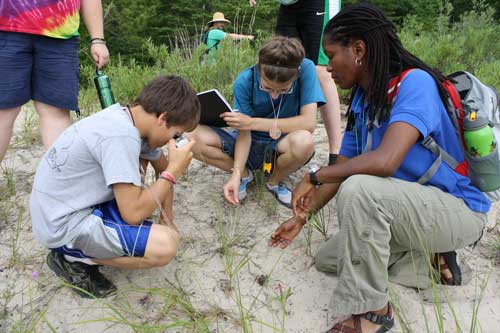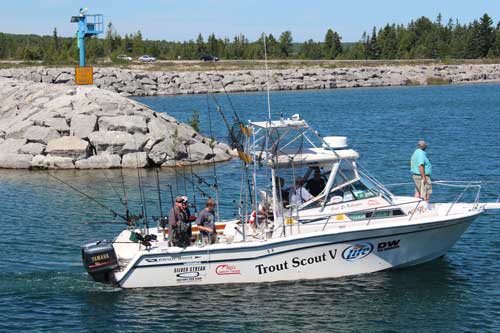Great Lakes and Natural Resources camp chosen for national 4-H case study
Michigan 4-H's Great Lakes and Natural Resources Camp selected as one of 10 in the nation to be part of National 4-H case study on successful science programs.

Beyond the 70 campers and number of counselors and educators, there were a few special guests at Michigan 4-H’s recent Great Lakes and Natural Resources Camp. Three members of the national 4-H office visited the camp as observers as the camp was named one of 10 science initiatives in the nation to become a part of an in-depth case study on high-quality, successful 4-H science programs.
 The camp, which was held in early August, featured representatives from the National 4-H Council and Policy Studies Associates (PSA) visited the camp and conducted evaluations on its effectiveness, and reportedly came away from the experience admiring with what they saw.
The camp, which was held in early August, featured representatives from the National 4-H Council and Policy Studies Associates (PSA) visited the camp and conducted evaluations on its effectiveness, and reportedly came away from the experience admiring with what they saw.
“They seemed very impressed,” said Judy Ratkos, program leader for the camp. But, Ratkos continued, they couldn’t talk in any detail about what they observed and spent most of their time asking a lot of questions and conducting a lot of interviews with campers and educators during their two-day visit.
Being selected for the case study is just the latest national recognition Great Lakes and Natural Resources Camp has received. Previously it has been named a National 4-H Program of Distinction and received an award from National 4-H and U.S. Fish and Wildlife Service for Natural Resources Conservation Education.
“We’re delighted to be recognized as one of the top 4-H programs in the nation,” Ratkos said after the camp had concluded.
 Held annually at Camp Chickagami in Presque Isle, Great Lakes and Natural Resources Camp is offered to students 13 to 15 years old, and offers all the fun of a typical camp with in-depth, hands-on education about the Great Lakes and other Michigan natural resources. It also offers participants a chance to explore careers related to biology and earth sciences and helps them prepare for the upcoming school year.
Held annually at Camp Chickagami in Presque Isle, Great Lakes and Natural Resources Camp is offered to students 13 to 15 years old, and offers all the fun of a typical camp with in-depth, hands-on education about the Great Lakes and other Michigan natural resources. It also offers participants a chance to explore careers related to biology and earth sciences and helps them prepare for the upcoming school year.
“The camp is designed to provide high-quality experiences that increase teens’ appreciation and knowledge of the outdoors and natural resources,” Ratkos said.
And a large part of the quality comes from the beautiful surroundings. Presque Isle is home to lighthouses, a marina, coastal wetlands, dunes, a limestone quarry, diverse watersheds and a national marine sanctuary.
“One student, in his final evaluation of the camp, said that he had learned more in his two one-week trips to camp the past two years than he had in all his previous science classes combined,” Ratkos said.
And in one evaluation, Grand Traverse County teen Nate Carson wrote, “I really benefitted from this camp by learning new things about leadership and why we need to conserve our natural resources. This camp opened up my horizons. I love how it has given me skills I will be able to use elsewhere.”
“Reading things like that,” Ratkos said, “along with getting recognized by National 4-H is an extremely gratifying experience.”
Following their in-person study of the camp, representatives from National 4-H Council and PSA will review the assessment forms and impact results of the camp. The case study is part of a three-year effort to evaluate the national 4-H Science Initiative.
Beyond the 70 campers and number of counselors and educators, there were a few special guests at Michigan 4-H’s recent Great Lakes and Natural Resources Camp. Three members of the national 4-H office visited the camp as observers as the camp was named one of 10 science initiatives in the nation to become a part of an in-depth case study on high-quality, successful 4-H science programs.
The camp, which was held in early August, featured representatives from the National 4-H Council and Policy Studies Associates (PSA) visited the camp and conducted evaluations on its effectiveness, and reportedly came away from the experience admiring with what they saw.
“They seemed very impressed,” said Judy Ratkos, program leader for the camp. But, Ratkos continued, they couldn’t talk in any detail about what they observed and spent most of their time asking a lot of questions and conducting a lot of interviews with campers and educators during their two-day visit.
Being selected for the case study is just the latest national recognition Great Lakes and Natural Resources Camp has received. Previously it has been named a National 4-H Program of Distinction and received an award from National 4-H and U.S. Fish and Wildlife Service for Natural Resources Conservation Education.
“We’re delighted to be recognized as one of the top 4-H programs in the nation,” Ratkos said after the camp had concluded.
Held annually at Camp Chickagami in Presque Isle, Great Lakes and Natural Resources Camp is offered to students 13 to 15 years old, and offers all the fun of a typical camp with in-depth, hands-on education about the Great Lakes and other Michigan natural resources. It also offers participants a chance to explore careers related to biology and earth sciences and helps them prepare for the upcoming school year.
“The camp is designed to provide high-quality experiences that increase teens’ appreciation and knowledge of the outdoors and natural resources,” Ratkos said.
And a large part of the quality comes from the beautiful surroundings. Presque Isle is home to lighthouses, a marina, coastal wetlands, dunes, a limestone quarry, diverse watersheds and a national marine sanctuary.
“One student, in his final evaluation of the camp, said that he had learned more in his two one-week trips to camp the past two years than he had in all his previous science classes combined,” Ratkos said.
And in one evaluation, Grand Traverse County teen Nate Carson wrote, “I really benefitted from this camp by learning new things about leadership and why we need to conserve our natural resources. This camp opened up my horizons. I love how it has given me skills I will be able to use elsewhere.”
“Reading things like that,” Ratkos said, “along with getting recognized by National 4-H is an extremely gratifying experience.”
Following their in-person study of the camp, representatives from National 4-H Council and PSA will review the assessment forms and impact results of the camp. The case study is part of a three-year effort to evaluate the national 4-H Science Initiative.



 Print
Print Email
Email




